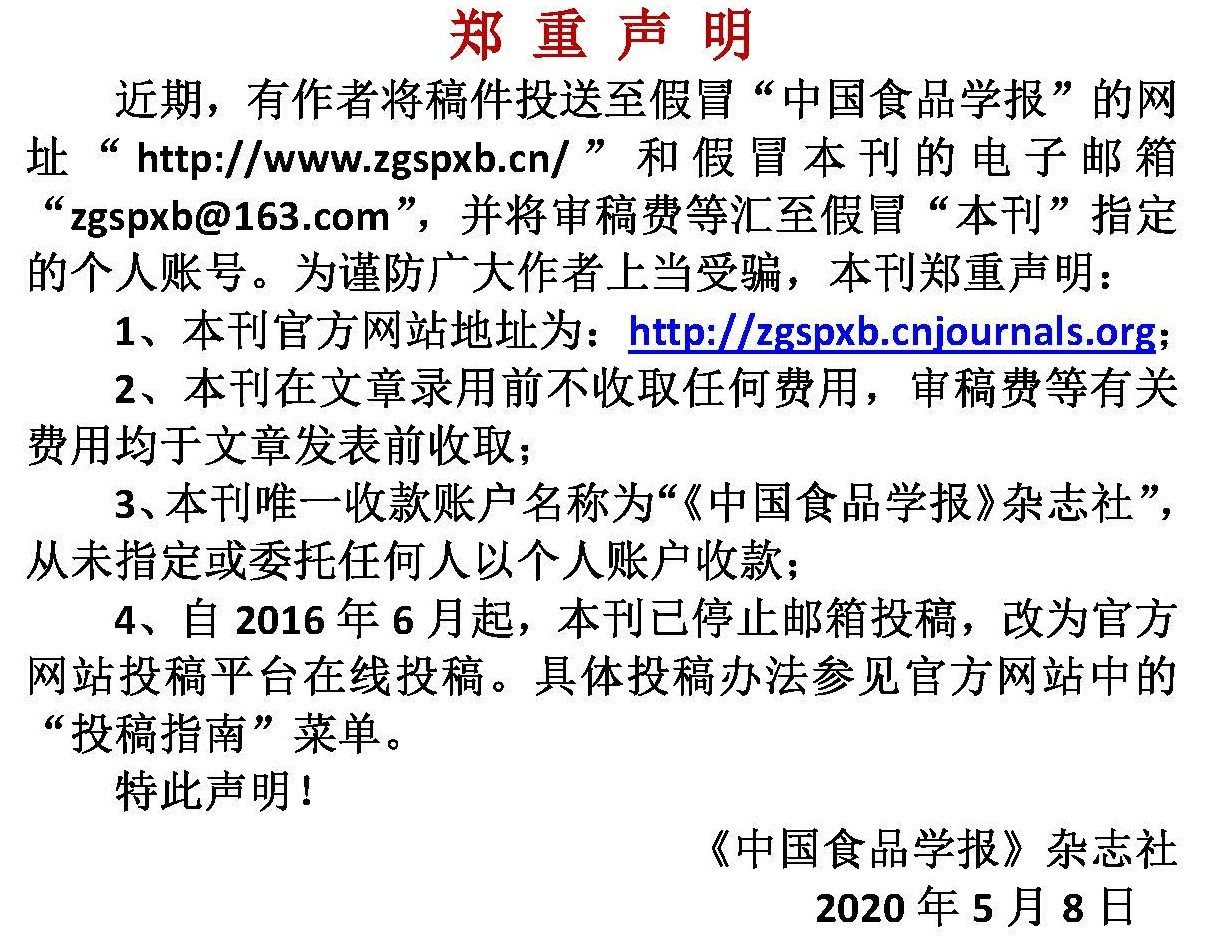(1.佛山科学技术学院 食品科学与工程学院 广东佛山 528231;2.中国农业科学院农业资源与农业区划研究所 农业农村部农业微生物资源收集与保藏重点实验室 北京 100081;3.广东省传统发酵食品工程技术研究中心 广东佛山 528231;4.广东省食品流通安全控制工程技术研究中心 广东佛山 528231;5.佛山市酿造工程技术研究中心 广东佛山 528231;6.佛山市农业生物制造工程技术研究中心 广东佛山 528231)
广东省基础与应用基础研究基金区域联合基金-青年基金项目(2019A1515110973,2019A 1515110036);农业农村部农业微生物资源收集与保藏重点实验室开放基金项目(KLMRCP2021-11);国家自然科学基金项目(32101926,32072198);广东省自然科学基金项目(2020A1515011444);广东省教育厅重点领域专项(2020ZDZX1029,2020ZDZX104);佛山市科技奖培育入库项目(2020001003715)
- Wang Ali 1,2,3,4,5,6
Wang Ali
School of Food Science and Engineering, Foshan University, Foshan 528231, Guangdong;Institute of Agricultural Resources and Regional Planning, Chinese Academy of Agricultural Sciences, Key Laboratory of Microbial Resources Collection and Preservation, Ministry of Agriculture and Rural Affairs, Beijing 100081;Guangdong Engineering Research Center for Traditional Fermented Food, Foshan 528231, Guangdong;Guangdong Engineering Research Center for Safety Control of Food Circulation, Foshan 528231, Guangdong;Foshan Engineering Research Center for Brewing Technology, Foshan 528231, Guangdong;Foshan Engineering Research Center for Agricultural Biomanufacturing, Foshan 528231, Guangdong
在期刊界中查找
在百度中查找
在本站中查找 - Wang Ziqian 1,3,4,5,6
Wang Ziqian
School of Food Science and Engineering, Foshan University, Foshan 528231, Guangdong;Guangdong Engineering Research Center for Traditional Fermented Food, Foshan 528231, Guangdong;Guangdong Engineering Research Center for Safety Control of Food Circulation, Foshan 528231, Guangdong;Foshan Engineering Research Center for Brewing Technology, Foshan 528231, Guangdong;Foshan Engineering Research Center for Agricultural Biomanufacturing, Foshan 528231, Guangdong
在期刊界中查找
在百度中查找
在本站中查找 - Wei Ziqing 1,3,4,5,6
Wei Ziqing
School of Food Science and Engineering, Foshan University, Foshan 528231, Guangdong;Guangdong Engineering Research Center for Traditional Fermented Food, Foshan 528231, Guangdong;Guangdong Engineering Research Center for Safety Control of Food Circulation, Foshan 528231, Guangdong;Foshan Engineering Research Center for Brewing Technology, Foshan 528231, Guangdong;Foshan Engineering Research Center for Agricultural Biomanufacturing, Foshan 528231, Guangdong
在期刊界中查找
在百度中查找
在本站中查找 - Yu Xiya 1,3,4,5,6
Yu Xiya
School of Food Science and Engineering, Foshan University, Foshan 528231, Guangdong;Guangdong Engineering Research Center for Traditional Fermented Food, Foshan 528231, Guangdong;Guangdong Engineering Research Center for Safety Control of Food Circulation, Foshan 528231, Guangdong;Foshan Engineering Research Center for Brewing Technology, Foshan 528231, Guangdong;Foshan Engineering Research Center for Agricultural Biomanufacturing, Foshan 528231, Guangdong
在期刊界中查找
在百度中查找
在本站中查找 - Zhang Pei 1,3,4,5,6
Zhang Pei
School of Food Science and Engineering, Foshan University, Foshan 528231, Guangdong;Guangdong Engineering Research Center for Traditional Fermented Food, Foshan 528231, Guangdong;Guangdong Engineering Research Center for Safety Control of Food Circulation, Foshan 528231, Guangdong;Foshan Engineering Research Center for Brewing Technology, Foshan 528231, Guangdong;Foshan Engineering Research Center for Agricultural Biomanufacturing, Foshan 528231, Guangdong
在期刊界中查找
在百度中查找
在本站中查找 - Huang Guidong 1,3,4,5,6
Huang Guidong
School of Food Science and Engineering, Foshan University, Foshan 528231, Guangdong;Guangdong Engineering Research Center for Traditional Fermented Food, Foshan 528231, Guangdong;Guangdong Engineering Research Center for Safety Control of Food Circulation, Foshan 528231, Guangdong;Foshan Engineering Research Center for Brewing Technology, Foshan 528231, Guangdong;Foshan Engineering Research Center for Agricultural Biomanufacturing, Foshan 528231, Guangdong
在期刊界中查找
在百度中查找
在本站中查找
(1.School of Food Science and Engineering, Foshan University, Foshan 528231, Guangdong;2.Institute of Agricultural Resources and Regional Planning, Chinese Academy of Agricultural Sciences, Key Laboratory of Microbial Resources Collection and Preservation, Ministry of Agriculture and Rural Affairs, Beijing 100081;3.Guangdong Engineering Research Center for Traditional Fermented Food, Foshan 528231, Guangdong;4.Guangdong Engineering Research Center for Safety Control of Food Circulation, Foshan 528231, Guangdong;5.Foshan Engineering Research Center for Brewing Technology, Foshan 528231, Guangdong;6.Foshan Engineering Research Center for Agricultural Biomanufacturing, Foshan 528231, Guangdong)
引用本文
王阿利,王子谦,魏梓晴,于茜雅,张沛,黄桂东.酱油酿造中微生物群落演替及其空间异质性研究[J].中国食品学报,2022,22(12):257-266
复制分享
文章指标
- 点击次数:583
- 下载次数: 342
- HTML阅读次数: 321
历史
- 收稿日期:2021-12-18
- 在线发布日期: 2023-01-09
文章二维码

地址 :北京市海淀区阜成路北三街8号9层 邮政编码 :100048
电话 :010-65223596 65265375 电子邮箱 :chinaspxb@vip.163.com
技术支持:北京勤云科技发展有限公司

